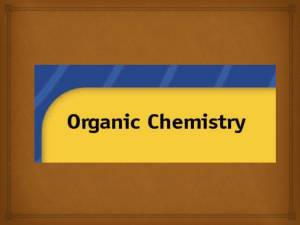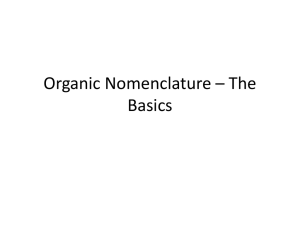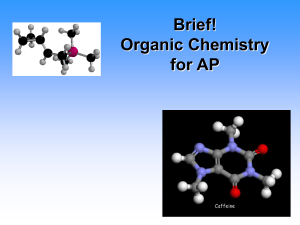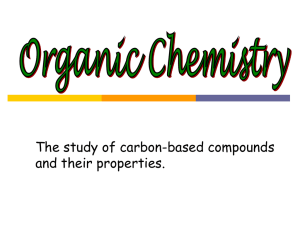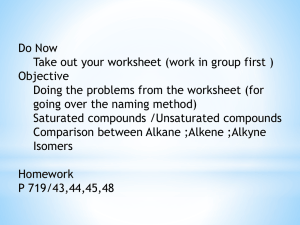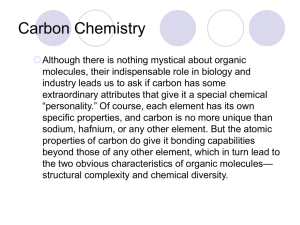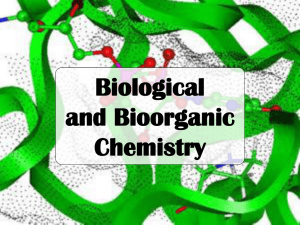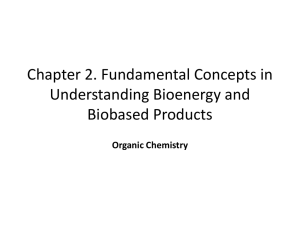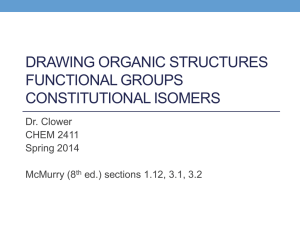Chapter 21 Powerpoint
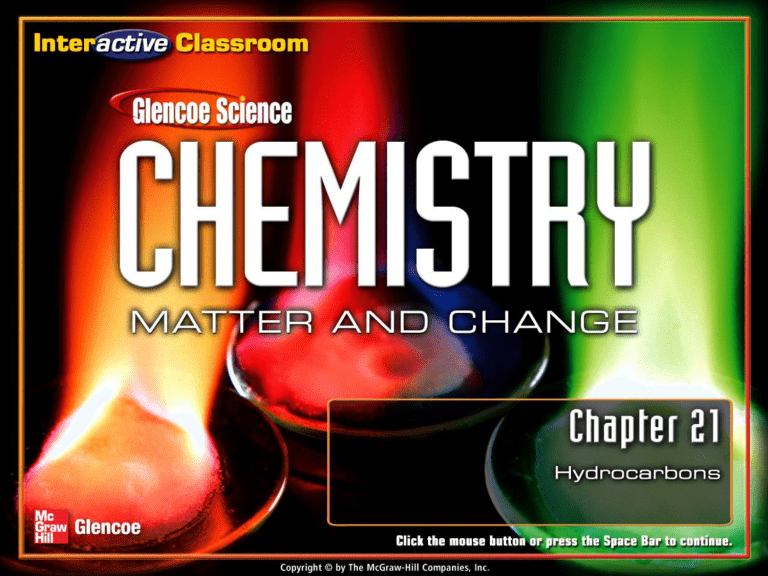
Hydrocarbons
Introduction to
Hydrocarbons
Alkanes
Alkenes and Alkynes
Hydrocarbon Isomers
Aromatic
Hydrocarbons
Click a hyperlink or folder tab to view the corresponding slides.
Exit
Chapter Menu
Section 21.1 Introduction to Hydrocarbons
• Explain the terms organic compound and organic chemistry.
• Identify hydrocarbons and the models used to represent them.
• Distinguish between saturated and unsaturated hydrocarbons.
• Describe where hydrocarbons are obtained and how they are separated.
microorganism: a tiny organism, such as a bacterium or a protozoan, that cannot be seen without a microscope
Section 21-1
Section 21.1 Introduction to Hydrocarbons
(cont.) organic compound hydrocarbon saturated hydrocarbon unsaturated hydrocarbon fractional distillation cracking
Hydrocarbons are carbon-containing organic compounds that provide a source of energy and raw materials.
Section 21-1
Organic Compounds
• Chemists in the early 19th century knew living things produced a variety of carbon compounds, called “organic” compounds.
• They were not able to synthesize them in the lab and labeled them as mysterious.
• Wöhler was the first to produce an organic compound in the lab.
Section 21-1
Organic Compounds
(cont.)
• Organic compound is applied to all carbon-containing compounds with the primary exceptions of carbon oxides, carbides, and carbonates, which are considered inorganic.
• In organic compounds, carbon nearly always shares its electrons and forms four covalent bonds.
Section 21-1
Organic Compounds
(cont.)
• Carbon atoms are bonded to hydrogen atoms or other elements near carbon on the periodic table.
• Carbon atoms also bond to other carbon atoms and form long chains.
Section 21-1
Hydrocarbons
• The simplest organic compounds are hydrocarbons , which consist of only the elements carbon and hydrogen.
• There are thousands of hydrocarbons.
Section 21-1
Hydrocarbons
(cont.)
• Carbon atoms bond to each other by single, double, and triple bonds.
• Saturated hydrocarbons contain only single bonds.
• Unsaturated hydrocarbons contain at least one double or triple bond.
Section 21-1
Refining Hydrocarbons
• Many hydrocarbons are obtained from the fossil fuel petroleum.
• Fractional distillation involves boiling petroleum and collecting each group of components as they condense at different temperatures.
Section 21-1
Refining Hydrocarbons
(cont.)
Section 21-1
Refining Hydrocarbons
(cont.)
• Fractional distillation towers do not yield fractions in proportion to demand.
• Heavier fractions are converted to gasoline or other lighter fractions by a process called cracking .
Section 21-1
Refining Hydrocarbons
(cont.)
• Gasoline is not a pure substance.
• Most molecules have 5 to 12 carbons.
• Gasoline is modified by adjusting its composition to improve performance, resulting in the octane rating system.
Section 21-1
Section 21.1 Assessment
Petroleum is separated into usable parts by boiling and condensing each component in a process called ____.
A.
cracking
B.
fractional distillation
C.
saturation
D.
bonding
A
0%
A. A
B. B
B
0%
C. C
0% 0%
D. D
C D
Section 21-1
Section 21.1 Assessment
What is a hydrocarbon that contains only single bonds called?
A.
unsaturated
B.
organic
C.
saturated
D.
fully bonded
A
0%
A. A
B. B
B
0%
C. C
0%
D. D
C
0%
D
Section 21-1
End of Section 21-1
Section 21.2 Alkanes
• Name alkanes by examining their structures.
• Draw the structure of an alkane when given its name.
• Describe the properties of alkanes.
IUPAC (International Union of Pure and Applied
Chemistry): an international group that aids communication between chemists by setting rules and standards in areas such as chemical nomenclature, terminology, and standardized methods
Section 21-2
Section 21.2 Alkanes
(cont.) alkane homologous series parent chain substituent group cyclic hydrocarbon cycloalkane
Alkanes are hydrocarbons that contain only single bonds.
Section 21-2
Straight-Chain Alkanes
• Alkanes are hydrocarbons that have only single bonds between atoms.
Section 21-2
Straight-Chain Alkanes
(cont.)
• The names of alkanes end in –ane .
• Prefixes are derived from Greek numbers.
• A series of compounds that differ from one another by a repeating unit is called a homologous series .
Section 21-2
Straight-Chain Alkanes
(cont.)
Section 21-2
Branched-Chain Alkanes
• Carbon atoms can bond to one, two, three, or four other carbon atoms making a variety of chains possible.
Section 21-2
Branched-Chain Alkanes
(cont.)
• Straight chains and branched chains can have the same molecular formula.
• Order and arrangement of atoms in organic compounds determine their identities.
• When naming branched chain alkanes, the longest continuous chain of carbon atoms is called the parent chain .
• All the side branches are known as substituent groups .
Section 21-2
Branched-Chain Alkanes
(cont.)
Section 21-2
Branched-Chain Alkanes
(cont.)
• Naming branched-chain alkanes
− Count the number of carbon atoms in the longest continuous chain.
− Number each carbon in the parent chain.
− Name each alkyl group substituent.
− If the same alkyl group appears more than once as a branch on the parent structure, use a prefix to indicate how many times it appears.
− When different alkyl groups are attached to the same parent chain, place their names in alphabetical order.
Section 21-2
Branched-Chain Alkanes
(cont.)
• Naming branched-chain alkanes
− Write the entire name, using hyphens to separate numbers from words and commas to separate numbers.
Section 21-2
Cycloalkanes
• An organic compound that contains a hydrocarbon ring is called a cyclic hydrocarbon .
• Cyclic hydrocarbons with only single bonds are called cycloalkanes .
Section 21-2
Cycloalkanes
(cont.)
• Naming substituted cycloalkanes is the same as straight-chains but with a few exceptions.
− The ring is always considered the parent chain.
− Numbering starts on the carbon that is bonded to the substituent.
− When more than one carbon has a substituent, number in the direction that gives the lowest possible numbers for the substituents.
Section 21-2
Properties of Alkanes
• Structure affects molecular properties.
• Alkanes are not polar and are good solvents for other nonpolar molecules.
Section 21-2
Properties of Alkanes
(cont.)
• Physical properties of alkanes
− Compared to water, methane boils and melts and lower temperatures.
− Methane molecules have little intermolecular attraction compared to water.
Section 21-2
Properties of Alkanes
(cont.)
• Chemical properties of alkanes
− Alkanes have low reactivity because they are nonpolar and have no charge, and because they have strong single bonds between carbon atoms.
Section 21-2
Section 21.2 Assessment
What is a cyclic alkane with no substituents groups and 6 carbon atoms?
A.
heptane
B.
cycloheptane
C.
cyclohexane
D.
cyclobutane
A
0%
A. A
B. B
B
0%
C. C
0%
D. D
C
0%
D
Section 21-2
Section 21.2 Assessment
Alkanes contain how many double bonds?
A.
greater than 2
B.
2
C.
1
D.
0
A
0%
A. A
B. B
B
0%
C. C
0%
D. D
C
0%
D
Section 21-2
End of Section 21-2
Section 21.3 Alkenes and Alkynes
• Compare the properties of alkenes and alkynes with those of alkanes.
• Describe the molecular structures of alkenes and alkynes.
• Name an alkene or alkyne by examining its structure.
• Draw the structure of an alkene or alkyne by analyzing its name.
hormone: chemical produced in one part of an organism and transported to another part, where it causes a physiological change
Section 21-3
Section 21.3 Alkenes and Alkynes
(cont.) alkene alkyne
Alkenes are hydrocarbons that contain at least one double bond, and alkynes are hydrocarbons that contain at least one triple bond.
Section 21-3
Alkenes
• Unsaturated hydrocarbons that contain at least one or more double covalent bonds between carbon atoms are called alkenes .
Section 21-3
Alkenes
(cont.)
• Alkenes are named in much the same way as alkanes.
• Alkenes end in –ene .
• When four or more carbon atoms are present, specify the location of the double bond.
Section 21-3
Alkenes
(cont.)
• When naming branched-chain alkenes, follow the same rules as for alkanes, with two exceptions.
− The parent chain is always the longest chain that contains double bond, whether it is the longest chain or not.
− The position of the double bond, not the branches, determine the numbering.
− Use a prefix to designate the number of double bonds.
Section 21-3
Alkenes
(cont.)
• Alkenes are nonpolar and have low solubility in water.
• Alkenes are more reactive than alkanes because the double bond increases electron density between the two carbon atoms, providing a good site for chemical reactivity.
Section 21-3
Alkynes
• Unsaturated hydrocarbons that contain one or more triple bonds between carbon atoms are called alkynes .
Section 21-3
Alkynes
(cont.)
• Straight-chain and branched-chain alkynes are named in the same way as alkenes, except the ending is –yne .
Section 21-3
Alkynes
(cont.)
• Alkynes have physical and chemical properties similar to alkenes but are generally more reactive because the triple bonds cause even larger electron densities than double bonds.
Section 21-3
Section 21.3 Assessment
Which of the following is generally the most reactive?
A.
cycloalkanes
B.
alkanes
C.
alkenes
D.
alkynes
A
0%
A. A
B. B
B
0%
C. C
0%
D. D
C
0%
D
Section 21-3
Section 21.3 Assessment
What is the name of a straight-chain hydrocarbon with six carbon atoms and a triple bond between the second and third carbon atoms?
A.
2-hexene
B.
3-hexene
C.
2-hexyne
D.
3-hexyne
A
0%
A. A
B. B
B
0%
C. C
0%
D. D
C
0%
D
Section 21-3
End of Section 21-3
Section 21.4 Hydrocarbon Isomers
• Distinguish between the two main categories of isomers —structural isomers and stereoisomers.
• Differentiate between geometric isomers with cisand transprefixes .
• Describe the structural variation in molecules that results in optical isomers.
electromagnetic radiation: transverse waves that carry energy through empty space
Section 21-4
Section 21.4 Hydrocarbon Isomers
(cont.) isomer structural isomer stereoisomer geometric isomer chirality asymmetric carbon optical isomer optical rotation
Some hydrocarbons have the same molecular formula but have different molecular structures.
Section 21-4
Structural Isomers
• Isomers are two or more compounds that have the same molecular formula but different molecular structures.
• Structural isomers have the same chemical formula but their atoms are bonded in different arrangements.
Section 21-4
Structural Isomers
(cont.)
• There are two main classes of isomers: structural isomers and stereoisomers.
• Structural isomers have different physical and chemical properties.
• The structure of a substance determines properties.
Section 21-4
Stereoisomers
• Stereoisomers are isomers in which all atoms are bonded in the same order but are arranged differently in space.
Section 21-4
Stereoisomers
(cont.)
• Geometric isomers result from different arrangements of groups around a double bond.
• Cis means on the same side, and trans means across from.
• Geometric isomers have different physical and chemical properties.
Section 21-4
Stereoisomers
(cont.)
Section 21-4
Chirality
• Louis Pasteur discovered two forms of crystallized tartaric acid.
• The forms were mirror images of each other called right and left-handed forms.
• The property in which a molecule exists in right and left-handed forms is called chirality .
Section 21-4
Optical Isomers
• Chirality occurs whenever a compound contains an asymmetric carbon.
• Asymmetric carbon is a carbon atom that has four different atoms or groups attached to it.
• The four groups can be arranged in two different ways.
Section 21-4
Optical Isomers
(cont.)
• Isomers that result from different arrangements of four different groups around a carbon atom represent the other class of stereoisomers, called optical isomers .
• Optical isomers have the same physical and chemical properties except in chemical reactions where chirality is important.
Section 21-4
Optical Isomers
(cont.)
• When polarized light passes through a solution containing an optical isomer, the plane of polarization is rotated to the right by the D-isomer and to the left by the Lisomer, producing and effect called optical rotation .
Section 21-4
Optical Isomers
(cont.)
Section 21-4
Section 21.4 Assessment
What are two molecules with the same formula but different structures called?
A.
isotopes
B.
chiral
C.
isomers
D.
asymmetric
A
0%
A. A
B. B
B
0%
C. C
0%
D. D
C
0%
D
Section 21-4
Section 21.4 Assessment
Which type of substances have the same physical and chemical properties but produce different optical rotations?
A.
isomers
B.
geometric isomers
C.
isotopes
D.
optical isomers
A
0%
A. A
B. B
B
0%
C. C
0%
D. D
C
0%
D
Section 21-4
End of Section 21-4
Section 21.5 Aromatic Hydrocarbons
• Compare and contrast the properties of aromatic and aliphatic hydrocarbons.
• Explain what a carcinogen is, and list some examples.
hybrid orbitals:
atomic orbitals that form during bonding by the rearrangement of valence electrons aromatic compound aliphatic compound
Aromatic hydrocarbons are unusually stable compounds with ring structures in which electrons are shared by many atoms.
Section 21-5
The Structure of Benzene
• Even by the middle of the 19th century, hydrocarbon ring structures remained unknown.
• Michael Faraday first isolated benzene in
1825.
• Chemists knew the formula was C
6
H
6 and proposed several possible models which would have all be very reactive, but benzene is unusually stable.
Section 21-5
The Structure of Benzene
(cont.)
• German chemist Friederich Kekulé claimed to have had a dream in which he realized the flat, hexagonal shape ring structure for benzene.
• Kekulé’s structure explained some of benzene's properties, but not its lack of reactivity.
Section 21-5
The Structure of Benzene
(cont.)
• Linus Pauling’s hybrid orbital theory explained benzenes lack of reactivity.
• The double bonds in benzene are not fixed, but rather the electrons are delocalized and shared among all six carbon atoms.
Section 21-5
Aromatic Compounds
• Organic compounds that contain benzene rings as part of their structure are called aromatic compounds .
• Aromatic was originally used because many benzene related compounds were found in pleasant smelling oils that came from plants and plant parts.
Section 21-5
Aromatic Compounds
(cont.)
• Aliphatic compounds are the alkane, alkene, and alkyne hydrocarbons, coming from the Greek word for fat because they were obtained by heating animal fat.
Section 21-5
Aromatic Compounds
(cont.)
• Substituted benzene compounds are named in the same way as cyclic alkanes.
Section 21-5
Aromatic Compounds
(cont.)
• Many aromatic compounds were commonly used as industrial and laboratory solvents.
• Health risks linked to aromatics include respiratory ailments, liver problems, and damage to the nervous system.
• Some aromatic compounds cause cancer.
Section 21-5
Section 21.5 Assessment
Aliphatic compounds were originally obtained from ____.
A.
fossil fuels
B.
animal fats
C.
plant oils
D.
minerals
A
0%
A. A
B. B
B
0%
C. C
0%
D. D
C
0%
D
Section 21-5
Section 21.5 Assessment
Which is NOT true of benzene?
A.
It is an aromatic compound.
B.
It has a flat hexagonal shape.
C.
The double bonds make it unstable.
D.
It has delocalized electrons.
A
0%
A. A
B. B
B
0%
C. C
0%
D. D
C
0%
D
Section 21-5
End of Section 21-5
Chemistry Online
Study Guide
Chapter Assessment
Standardized Test Practice
Image Bank
Concepts in Motion
Resources Menu
Section 21.1 Introduction to
Hydrocarbons
Key Concepts
• Organic compounds contain the element carbon, which is able to form straight chains and branched chains.
• Hydrocarbons are organic substances composed of carbon and hydrogen.
• The major sources of hydrocarbons are petroleum and natural gas.
• Petroleum can be separated into components by the process of fractional distillation.
Study Guide 1
Section 21.2 Alkanes
Key Concepts
• Alkanes contain only single bonds between carbon atoms.
• Alkanes and other organic compounds are best represented by structural formulas and can be named using systematic rules determined by the International
Union of Pure and Applied Chemistry (IUPAC).
• Alkanes that contain hydrocarbon rings are called cyclic alkanes.
Study Guide 2
Section 21.3 Alkenes and Alkynes
Key Concepts
• Alkenes and alkynes are hydrocarbons that contain at least one double or triple bond, respectively.
• Alkenes and alkynes are nonpolar compounds with greater reactivity than alkanes but with other properties similar to those of alkanes.
Study Guide 3
Section 21.4 Hydrocarbon Isomers
Key Concepts
• Isomers are two or more compounds with the same molecular formula but different molecular structures.
• Structural isomers differ in the order in which atoms are bonded to each other.
• Stereoisomers have all atoms bonded in the same order but arranged differently in space.
Study Guide 4
Section 21.5 Aromatic Hydrocarbons
Key Concepts
• Aromatic hydrocarbons contain benzene rings as part of their molecular structures.
• The electrons in aromatic hydrocarbons are shared evenly over the entire benzene ring.
Study Guide 5
Organic compounds must contain which elements?
A.
carbon
B.
oxygen
C.
hydrogen
D.
nitrogen
A
0%
A. A
B. B
B
0%
C. C
0%
D. D
C
0%
D
Chapter Assessment 1
Cyclohexane contains how many hydrogen atoms?
A.
6
B.
12
C.
14
D.
20
A
0%
A. A
B. B
B
0%
C. C
0%
D. D
C
0%
D
Chapter Assessment 2
Which of the following has the greatest reactivity?
A.
benzene
B.
hexane
C.
hexene
D.
hexyne
A
0%
A. A
B. B
B
0%
C. C
0%
D. D
C
0%
D
Chapter Assessment 3
A carbon bonded to four different groups is ____.
A.
cyclic
B.
aromatic
C.
asymmetric
D.
left-handed
A
0%
A. A
B. B
B
0%
C. C
0%
D. D
C
0%
D
Chapter Assessment 4
Where were aromatic compounds originally obtained from?
A.
fossil fuels
B.
plant oils, plant parts, and spices
C.
animal fats
D.
minerals
A
0%
A. A
B. B
B
0%
C. C
0%
D. D
C
0%
D
Chapter Assessment 5
Molecules that have the same formula and the atoms are bonded in the same order but are arranged differently in space, and have different properties are ____.
A.
structural isomers
B.
geometric isomers
C.
optical isomer
D.
sterioisotopes
A
0%
A. A
B. B
B
0%
C. C
0%
D. D
C
0%
D
STP 1
If n is the number of carbon atoms in a hydrocarbon, what is the general formula of a cyclic alkane?
A.
C n
H n+2
B.
C n
H
2n+2
C.
C n
H n
D.
C n
H
2n
B
A. A
B. B
0%
C. C
0%
D. D
C
0%
D A
0%
STP 2
Which does NOT describe what happens as a liquid freezes?
A.
The temperature of the system is increased.
B.
Energy is released by the system.
C.
The liquid is entering the solid phase.
D.
The molecules begin to form a lattice.
A
0%
B
A. A
B. B
0%
C. C
0%
D. D
C
0%
D
STP 3
What is a series of compounds that differ from one another by a repeating unit called?
A.
heterogeneous series
B.
homologous series
C.
straight-chain series
D.
branched-chain series
A
0%
A. A
B. B
B
0%
C. C
0%
D. D
C
0%
D
STP 4
What structural characteristic do all aromatic compounds share?
A.
They are composed of cyclohexane.
B.
They have a triple bond.
C.
They contain a benzene ring.
D.
They contain a cyclic alkane.
A
0%
A. A
B. B
B
0%
C. C
0%
D. D
C
0%
D
STP 5
Click on an image to enlarge.
IB Menu
IB 1
IB 2
IB 3
IB 4
IB 5
IB 6
IB 7
IB 8
IB 9
IB 10
IB 11
IB 12
IB 13
IB 14
IB 15
IB 16
IB 17
IB 18
IB 19
IB 20
IB 21
IB 22
Table 21.5
Examples of Alkenes
Table 21.6
Examples of Alkynes
Figure 21.17 Isomers of Pentane
Figure 21.25 Sigma- and Pi-bonding in Benzene
CIM
Click any of the background top tabs to display the respective folder.
Within the Chapter Outline, clicking a section tab on the right side of the screen will bring you to the first slide in each respective section.
Simple navigation buttons will allow you to progress to the next slide or the previous slide.
The Chapter Resources Menu will allow you to access chapter specific resources from the Chapter
Menu or any Chapter Outline slide. From within any feature, click the Resources tab to return to this slide.
The “Return” button will allow you to return to the slide that you were viewing when you clicked either the Resources or Help tab.
To exit the presentation, click the Exit button on the Chapter Menu slide or hit
Escape [Esc] on your keyboards while viewing any Chapter Outline slide.
Help
This slide is intentionally blank.
End of Custom Shows
